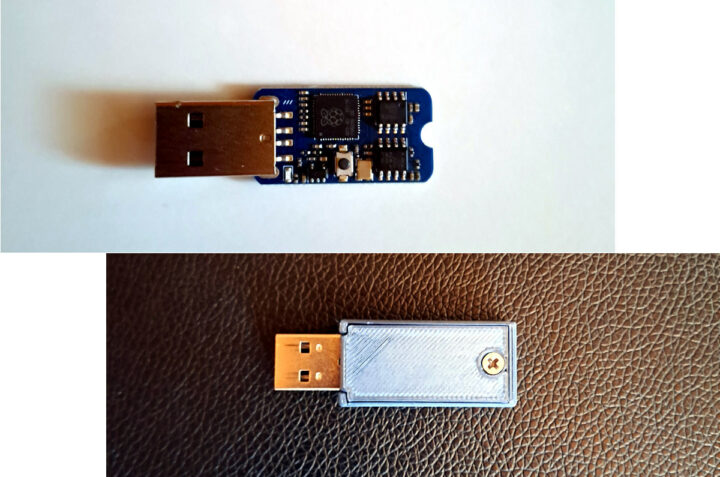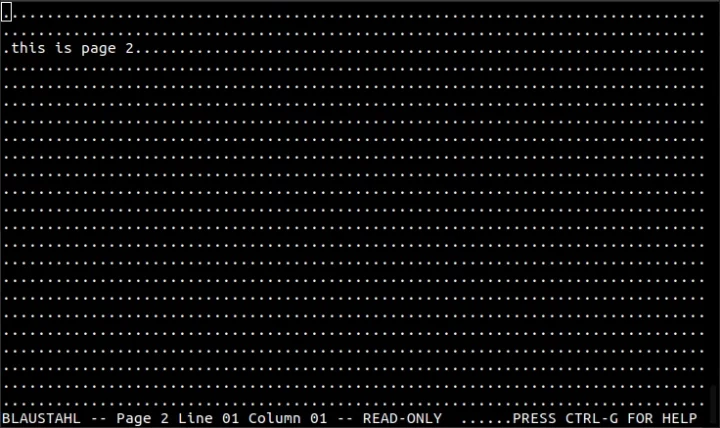Machdyne’s Blaustahl is a USB storage device equipped with a Raspberry Pi RP2040 MCU and 8KB of FRAM with a potential lifespan of over 200 years and designed for long-term storage of text up to about 8,000 characters.
FRAM (Ferroelectric RAM) has been around for years delivering ultra-low power consumption, faster writes, and ultra-long write endurance (one million billion read/write cycles) compared to EEPROM or NOR flash, but the cost is quite higher and it’s mostly used in applications that require ultra-low power consumption and non-volatile storage write capabilities such as data logging, sensor networks, batteryless applications. The Blaustahl storage device and USB text editor is one of those.

Blaustahl speciications:
- Microcontroller – Raspberry Pi RP2040 dual-core Cortex-M0 processor at 133MHz and 264kB RAM.
- Storage
- 4MB (32Mbit) NOR flash for firmware
- 8KB (64Kbit) FRAM (Fujitsu MB85RS64)
- Lifespan – 95 years @ +55°C, over 200 years @ +35°C
- Endurance – 10^12 read/write cycles @ +85°C
- Supports FRAM write protection via solder jumper
- USB – 1x USB Type-A male port; USB-CDC interface requires no additional drivers on most OSes
- Misc – Blue LED
- Security – Encryption coming soon in updated firmware
- Dimensions – Board: 30 x 16mm
- Blue 3D-printed PLA case

The Blaustahl USB FRAM device runs a built-in text editor accessible through a serial communication program with VT100 emulation support such as PuTTY, Tera Term, Minicom, screen, etc… You’ll find the RP2040 firmware (code and binary), schematics (PDF), and SCAD file for the enclosure on GitHub. Potential applications include password storage, cryptocurrency private key/ seed phrase storage, note/list storage, geocaching, and time capsules, or users could simply use it as a small FRAM development board.
I also wondered how FRAM would compare to other storage solutions. We’ve already seen the Futjisu FRAM can last up to 200 years (if we stay within the huge read/write cycle limit) at 35°C, while a NOR flash is limited to up to 20 years at 55°C according to Infineon, and NAND flash is supposed to last 16 to 20 years in the same conditions according to data from . EEPROM looks better with a 100 to 200 years data retention at 55°C, but with longer write times and significantly fewer write cycles than FRAM. All those will also depend on read/cycle cycles and other conditions like humidity levels. We also have to consider the complete device as if the RP2040 stops working after 30 years or the USB port becomes rusty to the point of being unusable, it does not matter that much to have a long-lasting FRAM chip although physical recovering methods (e.g. unsoldering) might still be possible.
Machdyne sells the Blaustahl USB FRAM storage device for 29.95 Euros and ships from Germany.

Jean-Luc started CNX Software in 2010 as a part-time endeavor, before quitting his job as a software engineering manager, and starting to write daily news, and reviews full time later in 2011.
Support CNX Software! Donate via cryptocurrencies, become a Patron on Patreon, or purchase goods on Amazon or Aliexpress




